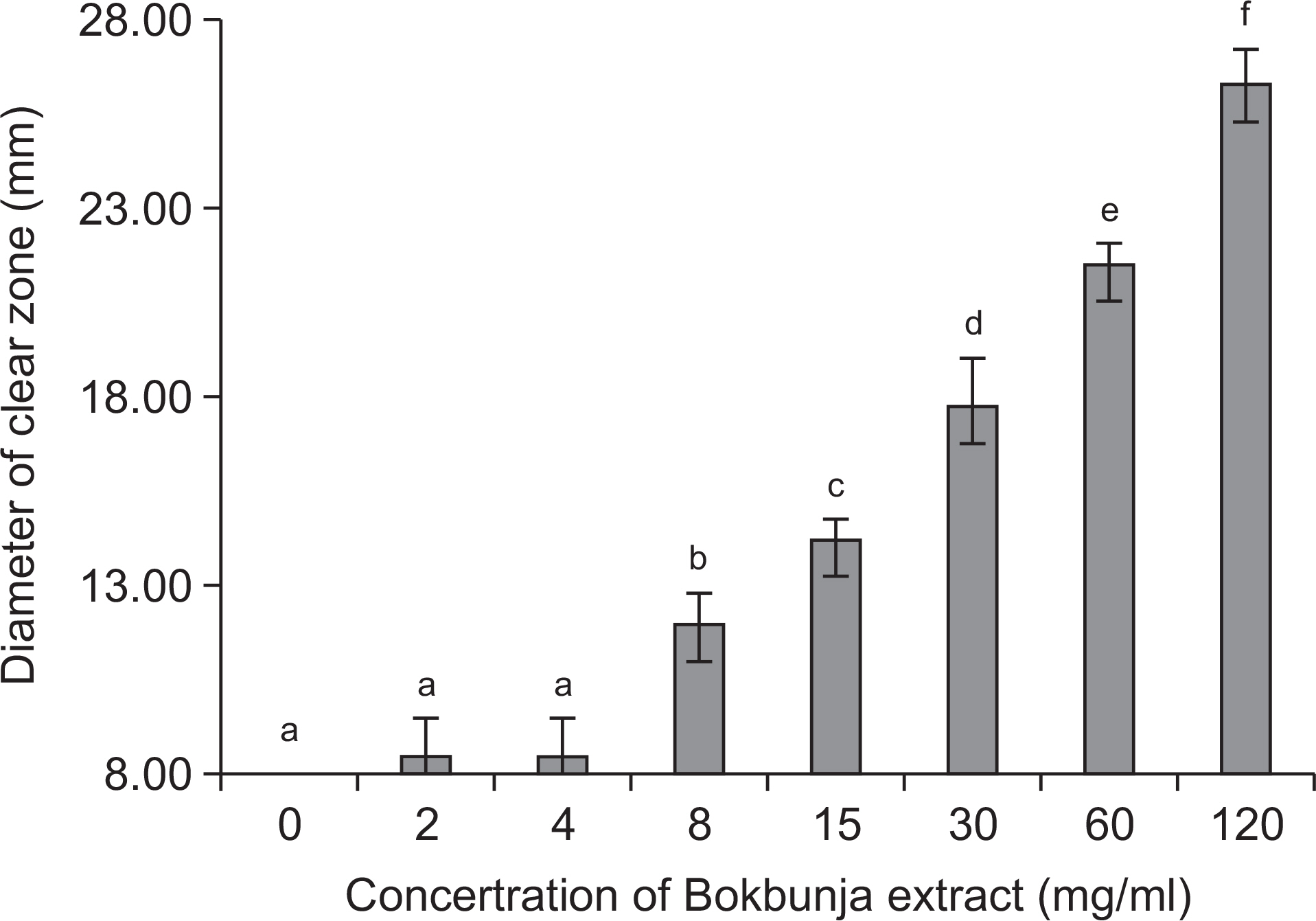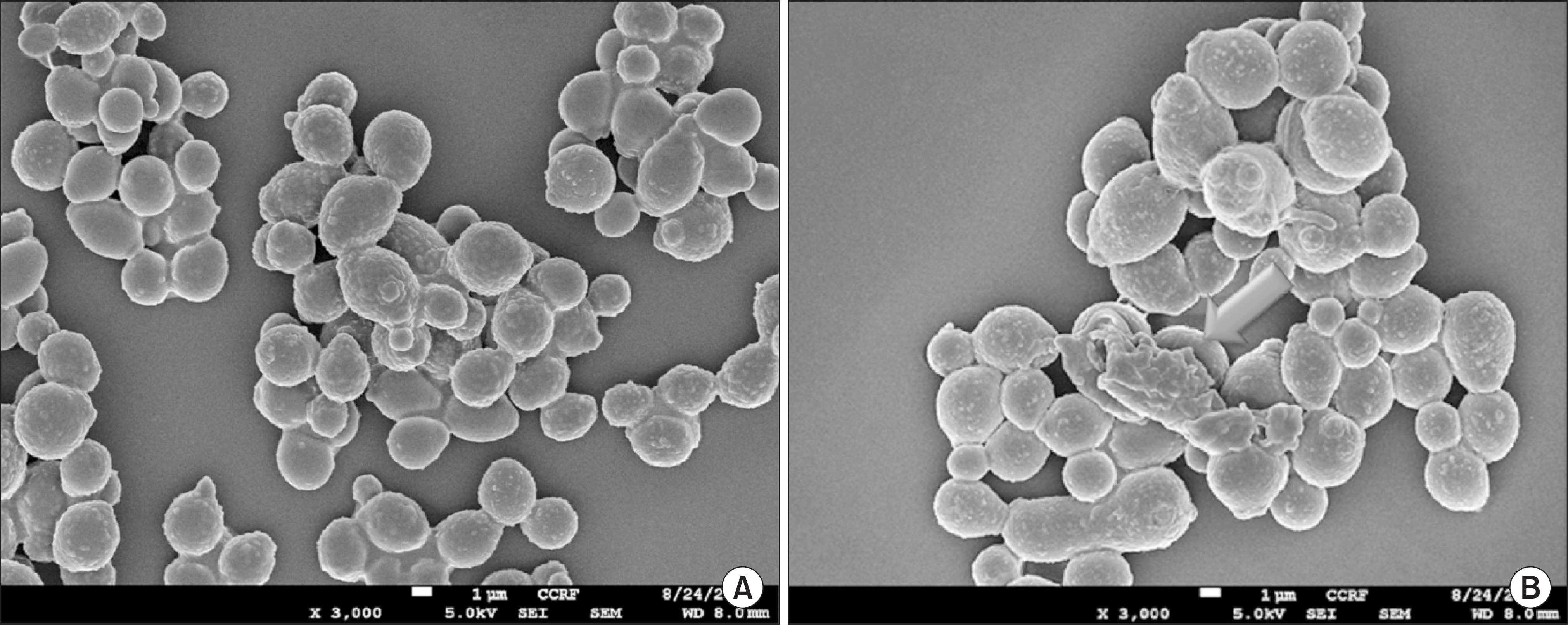J Korean Acad Oral Health.
2015 Sep;39(3):168-173. 10.11149/jkaoh.2015.39.3.168.
Growth inhibition effect of Rubus coreanus Miquel on Candida albicans
- Affiliations
-
- 1Department of Preventive & Public Health Dentistry, Chonnam National University School of Dentistry, Gwangju, Korea. sjhong@chonnam.ac.kr
- 2Department of Oral Microbiology, Chonnam National University School of Dentistry, Gwangju, Korea.
- 3Dental Science Research Institute, Chonnam National University School of Dentistry, Gwangju, Korea.
- KMID: 2149154
- DOI: http://doi.org/10.11149/jkaoh.2015.39.3.168
Abstract
OBJECTIVES
In this study, the growth inhibition effect of Rubus coreanus Miquel on Candida albicans (C. albicans) was observed.
METHODS
The Rubus coreanus Miquel was extracted with 70% methanol and concentrated with a rotary evaporator. Antifungal effect of Rubus coreanus Miquel extract on C. albicans was determined by paper disc diffusion method and standard plate count method. Seven different concentrations (2, 4, 8, 15, 30, 60, 120 mg/ml) of the extract were tested by paper disc diffusion method. Two kinds of concentration (8, 60 mg/ml) of the extract were tested using standard plate count method on C. albicans with different incubating time (for 6, 12, 24 hours immediately after the cultivation). Morphological changes of C. albicans cells after exposure to the extract were observed with scanning electron microscopy (SEM) images.
RESULTS
The Rubus coreanus Miquel extract showed an antifungal effect on C. albicans in 8, 15, 30, 60, 120 mg/ml of concentrations (P<0.05). The extract with 8 mg/ml of concentration showed about 30% of growth inhibition at 6 h and with 60 mg/ml it showed about 90% of growth inhibition at 24 h. SEM analysis showed damaged surfaces of C. albicans cells when treated with Rubus coreanus Miquel extract.
CONCLUSIONS
The Rubus coreanus Miquel might have the potential as a nobel growth inhibitory agent against C. albicans that causes oral infection.
Figure
Reference
-
References
1. Herbal resources plant recognized books compilation committee. Herbal resources plants. Seoul: Bumin publishing;2012. p. 189.2. Park JH. Korean medical herbal encyclopedia. Seoul: Shinilbooks;2012. p. 671.3. Jeon YH, Sun XQ, Kim MR. Antimicrobial Activity of the Ethanol Extract from Rubus coreanum against Microorganisms Related with Foodborne Illness. Korean J Food Cookery Sci. 2012; 28:9–14.
Article4. Lee KI, Kim SM, Kim SM, Pyo BS. Comparison of Fatty Acids and Antibacterial Activity against Pathogen of Acne in Different Parts of Ripened Black Raspberry (Rubus coreanus Miquel). J Korean Soc Food Sci Nutr. 2011; 40(3):466–469.
Article5. Park CG, Bang KH, Lee SE, Cha MS, Sung JS, Park HW, et al. Antibacterial activity from medicinal plant extracts on the Staphylococcus aureus. Korean J Medicinal Crop Sci. 2001; 9:251–258.6. Jeon YH, Choi SW, Kim MR. Antimutagenic and cytotoxic activity of ethanol and water extracts from Rubus coreanum. Korean J Food Cookery Sci. 2009; 25:379–386.7. Lee MW, Lee YA. Tannins from Rubus coreanum. Kor J Pharmacogn. 1995; 26:27–30.8. Bagg J, Macfarlane TW, Poxtone IR, Miller CH, Smith AJ. Essentials of microbiology for dental students. Seoul: Koonja publishing;2001. p. 295.9. Jeon HD, An KS, Park CW, Lee HS, Kim SG. Relationship between Adherence of Candida albicans to Human Buccal Epithelial Cells in Vitro and Their Virulence. J Hanyang Med Rev. 1987; 7:855–876.10. Kim MJ, Shin SW, Lee JY. In vitro study on the adherence and penetration of Candida albicans into denture soft lining materials. J Korean Acad Prosthodont. 2006; 44:466–476.11. Lee HO, Jeon JY, Kim KJ, Han DM, Han KY. Susceptibility test of Candida albicans isolated from Oral cavity. J Korean Acad Oral Health. 1997; 21:553–561.12. Madigan MT, Martinko JM, Dunlap PV, Clark DP. Biology of microorganisms. 12th ed. Seoul: Bio Science;2011. p. 160–161.13. Shin JH. Antifungal Resistance in Yeasts and Filamentous Fungi. In-fect Chemother. 2009; 41:65–71.
Article14. Kanafani ZA, Perfect JR. Antimicrobial resistance: resistance to antifungal agents: mechanisms and clinical impact. Clin Infect Dis jour. 2008; 46:102–128.15. Vengurlekar S, Sharma R, Trivedi P. Efficacy of some natural compounds as antifungal agents. Pharmacogn Rev. 2012; 6:91–99.
Article16. Bawankar R, Deepti VC, Singh P, Subashkumar R, Vivekanandhan G, Babu S. Evaluation of Bioactive Potential of an Aloe vera Sterol Extract. Phytother Res. 2013; 27:864–86.17. Mbaveng AT, Kuete V, Ngameni B, Beng VP, Ngadjui BT, Meyer JJ, et al. Antimicrobial activities of the methanol extract and compounds from the twigs of Dorstenia mannii (Moraceae). BMC Complement Altern Med. 2012; 12:83.
Article18. Höfling JF, Anibal PC, Obando-Pereda GA, Peixoto IAT, Furletti VF, Foglio MA, et al. Antimicrobial potential of some plant extracts against Candida species. Braz J Biol. 2010; 70:1065–1068.
Article19. Sangetha S, Zuraini Z, Sasidharan S, Suryani S. Fungicidal effect and oral acute toxicity of Cassia spectabilis leaf extract. Jpn J Med Mycol. 2008; 49:299–304.
Article20. Santos VR, Pimenta FJ, Aguiar MC, do Carmo MA, Naves MD, Mesquita RA. Oral candidiasis treatment with Brazilian ethanol propolis extract. Phytother Res. 2005; 19:652–654.
Article21. Lee BB, Ha YM, Shin SH, Je KM, Kim SR, Choi JS, et al. Antimicrobial Activity of Test Dentifrice Product Containing Grapefruit Seed Extract and Processed Sulfur Solution against Oral Pathogens. J life science. 2009; 19:956–962.22. Jo NP. Candidiasis. Journal of Korean Dental Association. 2004; 42:290–293.23. Kim YJ. Pathogenic microorganisms & antibiotics. Seoul: Wold sci-ence;2010. p. 349–354.24. Seong IW. Antifungal Activity of the Extracts from Galla rhois against Candida albicans. Korean J Med Mycol. 2007; 12:175–179.25. Lee JY. Antifungal Effect of Glycyrol against Infections due to Candida albicans and Its Mechanism[master’s thesis]. Seoul: Dongduk Womens University;2008. [Korean].26. Kim KH, Lee YA, Kim JS, Lee DI, Choi YW, Kim HH, et al. Antioxidative Activity of Tannins from Rubus coreanum. Arch Pharm Res. 2000; 44:354–357.27. Park HS, Min KJ, Cha CK, Song JW, Son JC. Anti-microbial activities against oral microbes and growth-inhibitory effect on oral tumor cell by extracts of paeonia lactiflora. Kor J Env Hlth. 2007; 33(1):21–29.28. Kang SK, Lee KS, Chon YH, Hong JP. Effect of chamaecyparis ob-tusa tree phytoncide on Candida albicans. J Oral Med Pain. 2010; 35(1):19–29.29. Lee MK, Lee HS, Choi GP, Oh DH, Lim JD, Yu CY, et al. Screening of biological activities of the extracts from Rubus coreanus Miq. Korean J Medicinal Crop Sci. 2003; 11:5–12.
- Full Text Links
- Actions
-
Cited
- CITED
-
- Close
- Share
- Similar articles
-
- Treatment for Two Cases of Acne Vulgaris with Rubus Coreanus Miquel Extract
- A Study of Potential Application of Rubus coreanus Miquel Extract for Seborrheic Dermatitis Treatment
- Effects of a Rubus coreanus Miquel supplement on plasma antioxidant capacity in healthy Korean men
- Phototoxic reaction to amidarone as studied with the mouse tail technique and the candida albicans test
- In vitro growth of candida albicans on several resilient dinture liners



